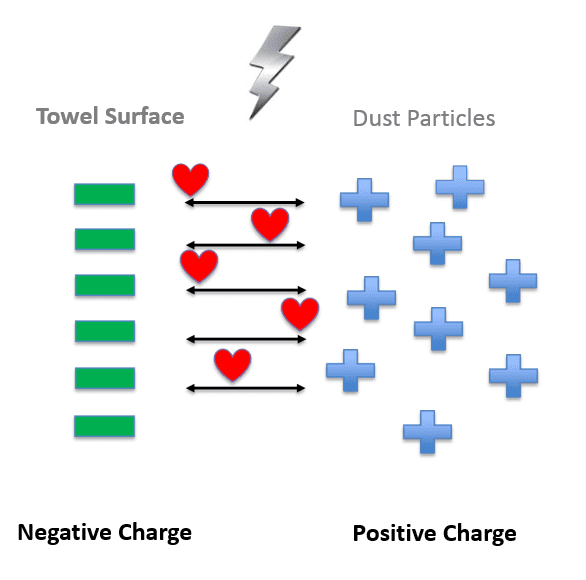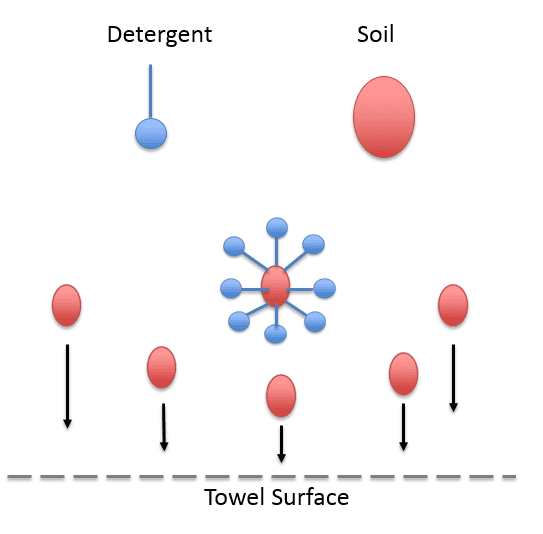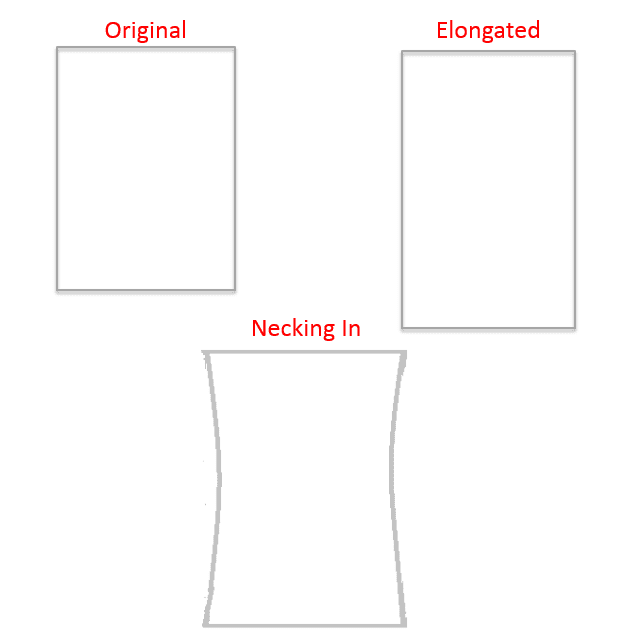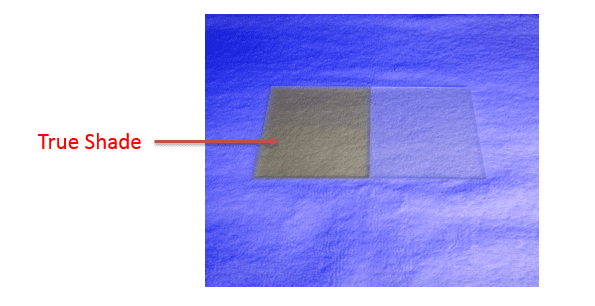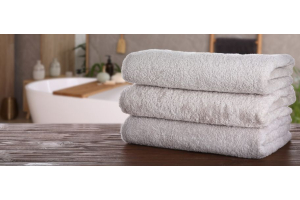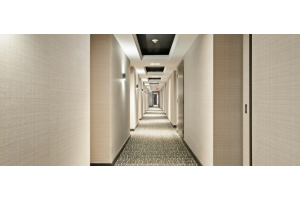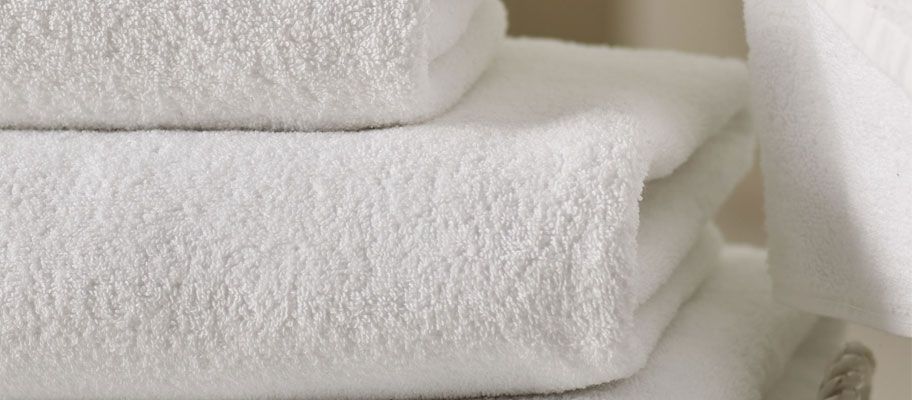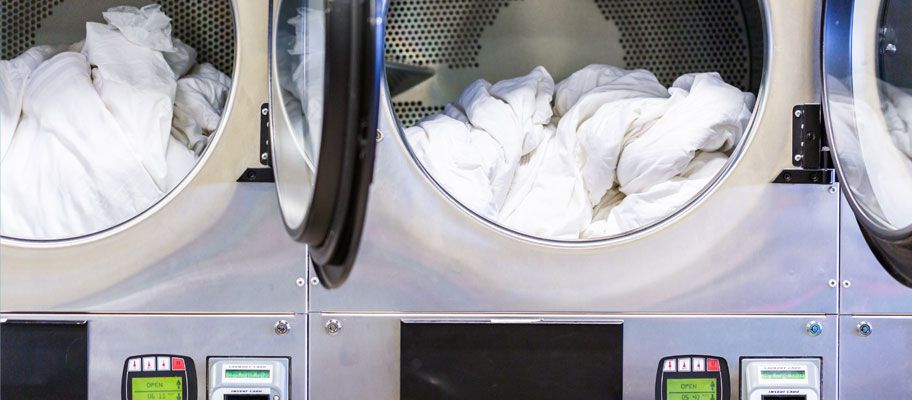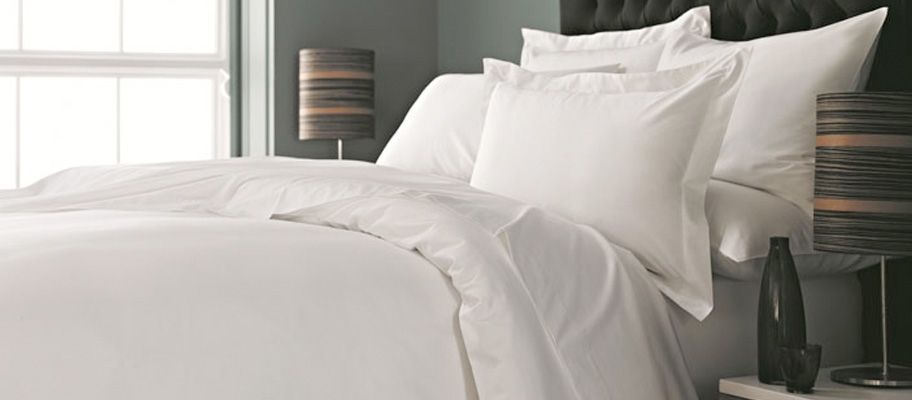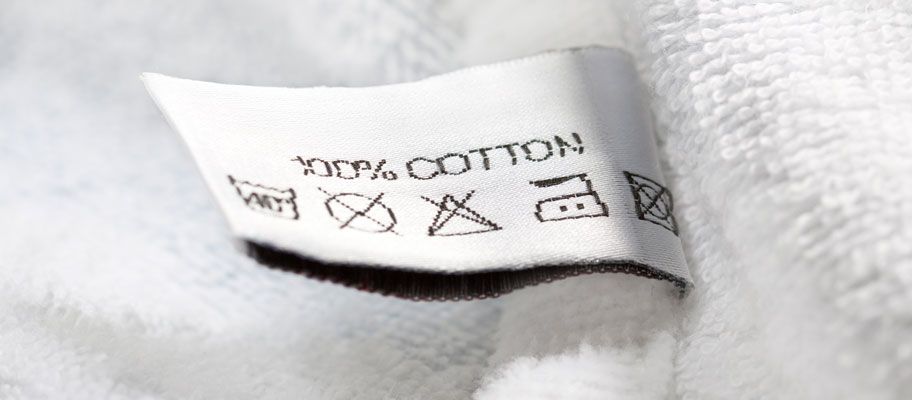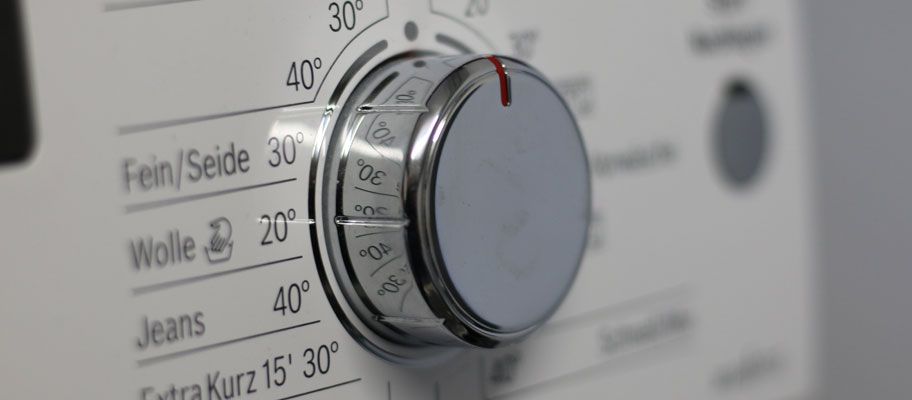We use cookies to give you the best possible experience. To accept cookies continue browsing, or view our Cookies Policy to find out more.
Preventing Common Linen Problems: From Grey Towels To Shrinking Bedding
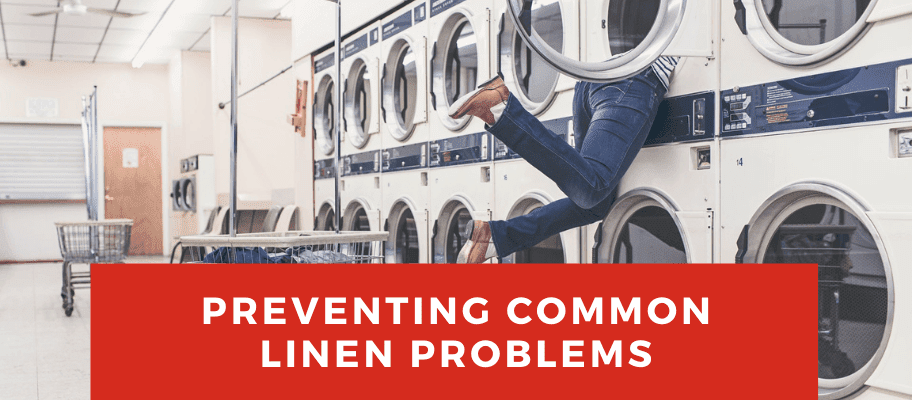
If you’ve recently bought some new bed or bath linen, then you obviously want to make sure that it remains in great condition for a long time. This is especially the case if you’re buying linen in bulk for an establishment such as hotel. After all, you can potentially waste thousands of pounds if the linen you’ve bought isn’t correctly cared for. So, in this article we’ll go into detail on all the things that can go wrong with linen and how to prevent them from happening in the first place.
We’ll go into detail on how these problems can happen and what the manufacturer, laundries and linen owners such as hotels can do to prevent such problems. You can also follow some of these guidelines when using linen at home.
Bear in mind that a lot of what can go wrong with linen is due to how the linen is treated during laundering and in use, rather than it being a manufacturing fault. But, of course, that all depends on who you have bought your linen from and whether they have a reputation for supplying quality linen. It’s always worth doing a little research for to ensure that who you are buying from is a reputable supplier.
List Of Contents
- What is towel greying and how can I prevent it?
- How to make sure that stains are removed from linen
- How creased bedding occurs and how to prevent it
- How bedding shrinks and how to prevent it
- How to prevent worn and frayed hems and towels
- How bleach damages linen and how to prevent it
- How the water quality can damage linen and how to prevent it
- Holes and tears in fabrics and how laundries can prevent them
- How bobbling and pilling can occur on bed linen
- How do towels become bald and how can I prevent it?
- Why do my towels have a harsh feel and how can I prevent this?
- How to prevent pulled threads on towels
- Why does my linen have a washed out look and how do I prevent this?
- Why do my towels still smell after they've been to the laundry?
What Is Towel Greying And How Can I Prevent It?
Greying is a common problem that’s often seen on towels. Towels will have a grey appearance, which is mainly caused by over drying the towel in the tumble dryer.
If the towels are bone dry when still tumbling around in the machine, the friction between the towels and between the towels and the machine generates a static charge. The surface of towels develops a negative electric charge, while the very fine dust particles which are present in the dryer air have a positive electric charge.
As we all know, opposites attract, so the dust particles become attracted to the fibres. Those very fine particles of dirt then become embedded in the fibre, which are impossible to remove. This results in the towel developing a grey appearance.
To prevent this from happening, the towels should be taken out of the dryer when there is still a small amount of moisture in the towel. That will prevent the static charge from building up. It doesn’t mean you have to pull the towels out when they are still wet, just make sure you check them when they are just about dry.
Greying can also happen if not enough detergent has been used in the wash. The detergent helps to remove the soil from the towel and then holds on to that soil in the water, keeping it off the towel.
If there is not enough detergent present, it can’t hold on to all the soil, so the dirt gets released back on to the towel. This means that it isn’t getting washed properly and looks grey.
On the other hand, the same thing can also happen if the wash process is too long. The detergent loses its power and releases the soil back on to the towel. To prevent this, you or your laundry needs to make sure that enough detergent is used to remove the level of soil present.
For more tips on keeping towels soft and fluffy, read our blog post on the topic.
How To Make Sure that Stains Are Removed From Linen
There’s no one-size-fits-all solution to tackling stains on bed, bath and table linen. Different types of stain need to be treated differently in order to remove them. But the key factor to remember is that they should all be washed as soon as possible after the stain occurs.
If the stains are protein based such as blood, food, oils etc. it’s very important that the stains are washed in cool water first, at a maximum temperature of 38C. The reason for this is because, if washed at 40C and above, the protein will essentially cook and become set in the fabric. This makes it very difficult or even impossible to remove.
Wash the linen at a low temperature first in order to loosen the stain from the fabric, followed by a hot wash to fully clean the fabric.
If, for example, there are blood stains on a bed sheet or towel, it wouldn’t do any harm to give it a quick rinse under the tap with a bit of soap before fully washing it (if time permits, of course).
If the stains are vegetable based such as tea, coffee, and red wine; they again need to be washed as soon as possible. Bleach may be necessary to fully remove the stains, but it’s essential that the bleaching is done properly so as not to damage the fabric. Be sure to read our guide on ‘the steps to safe textile bleaching’ to find out more.
When it comes to pillowcases, you might notice brown areas in the spot where the person’s head has laid. This can be hair oil, dead skin, and sweat. To remove this properly, pillowcases should ideally be washed in up to double the amount of detergent, with extra emulsifier to remove those oils properly.
How Creased Bedding Occurs And How To Prevent It
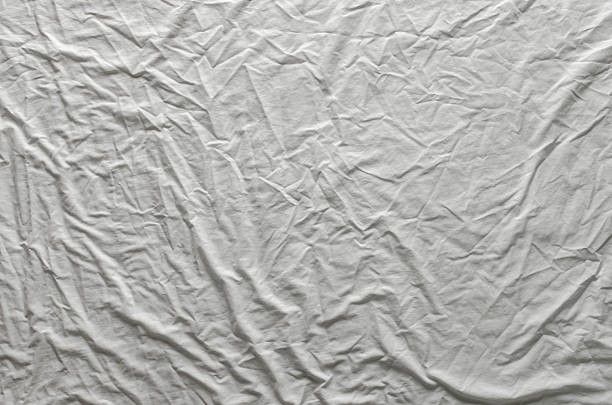
Bed sheets may sometimes come back from the laundry with all over creasing. A major cause of this is ironing the sheets when the fabric has dried out too much, so the fabric has dried in its creased position.
It’s important to note that finer fabrics with higher thread counts will dry out more quickly. It’s essential that ironing is done whilst the sheets are still damp to give a smooth crease free finish.
If the linen is new and it's creased after the initial wash before use, this could be because there is still some size chemical left on the fabric from weaving (remember that size is applied to strengthen the warp threads for weaving, find out more in our article here).
In this case, it either hasn’t been properly removed during the manufacturing process, or it could be that you or the laundry haven’t washed the new linen properly to full remove any leftover chemicals including size from manufacture. This is why new linen always needs a good wash in detergent before use. If you’re using a laundry, ask them about their process. As some laundries will just rinse and dry the new linen, which isn’t enough to remove these chemicals.
When it comes to polyester and polycotton blends, a reason for creasing could be thermal shock creasing. Thermal shock creasing happens when polyester fabrics are hot washed, making the polyester soften, become pliable, and ultimately moulds into its creased position. Polyester is a form of plastic so, like normal plastic, it becomes stretchy and bendable when it’s heated. When the fabric is then quickly cooled, the polyester hardens again and become set in its creased position.
To stop thermal shock from happening the temperature needs to be cooled slowly. This allows the polyester to move freely so it's not set into the creases.
How Bedding Shrinks And How To Prevent It
Have you suddenly found that your pillowcase won’t fit over your pillow anymore, or that a bed sheet no longer fits your bed? This is can either be due to shrinkage during the washing process or distortion caused during ironing (see the previous section for more about that).
Sometimes, the problem can occur during the manufacturing process. If a fabric has been over stretched in the length or the width during manufacturing, it will get cut and sewn into the final product in that stretched state. When it comes to be washed, the fabric will relax and shrink back to its unstretched size, causing the product to shrink.
It can take a few washes for the linen to fully shrink. Most of the shrinkage will be seen in the first 5 washes.
A common reason for shrinkage on fabrics that contain polyester is not actual shrinkage itself, but distortion on the iron. As previously mentioned, polyester softens and becomes stretchy when heated. So, when a polycotton duvet for example is ironed at temperatures above 165C the polyester starts to soften.
The pulling tensions on the iron will stretch the softened polyester in the ironing direction, so if its ironed in a lengthways direction then it will stretch out in the length and also pull in across the width, giving an elongated shape.
If ironed in the width direction, the width of a duvet cover, for example, will be stretched out and the length will pull in. This gives the impression that the duvet cover is suffering from a fabric fault and has shrunk during the wash when, actually, it has distorted during ironing. Again, if you’re using a laundry then it may be the fault of their process.
This stretching effect will become more obvious each time the item is passed through the iron (in the same direction).
Duvet covers and pillowcases can have an hour glass shape where they are wider at the top and the bottom than they are in the middle. This happens because the leading edge is pulled out either by clips, or by hand for pillowcases, as it is fed into the iron.
The middle isn’t pulled out to the same extent and the bottom may also be pulled out by hand. The hot ironing temperature and the pull on the fabric set it in this position. This is known as ‘necking in’.
Ultimately, to prevent ironing distortion you must iron the fabric below 165C. Take a look at the previous section for more tips.
How To Prevent Worn And Frayed Hems On Towels
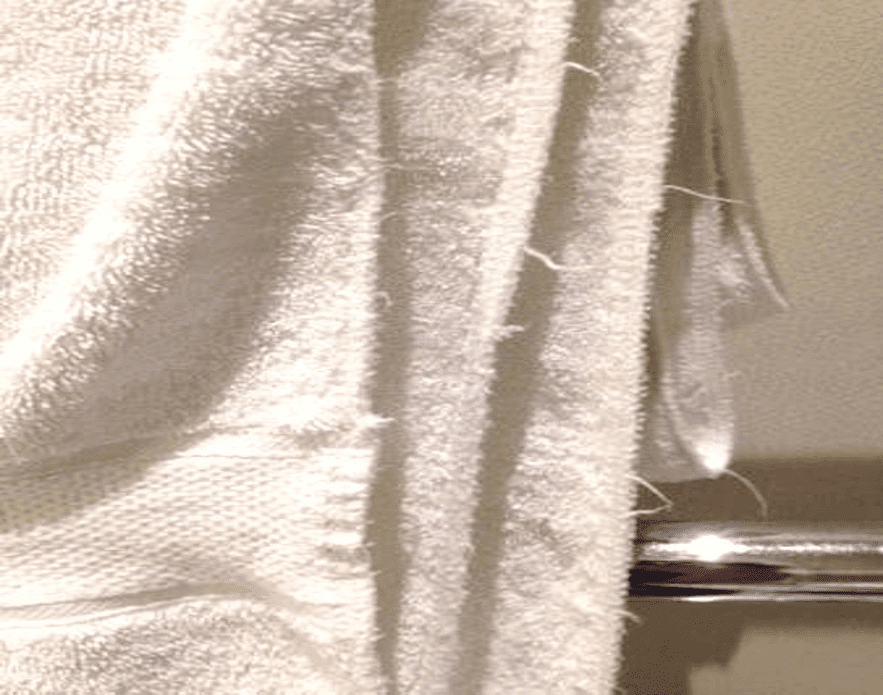
The main cause of worn and frays hems on towels is over drying in the tumble dryer. When the fibres of the towel get too dry, they become very brittle and break easily when they rub against other towels and the inside of the machine. The fibres on the hem edge are more exposed as they are on the surface and are therefore more susceptible to rubbing. The fibres that break ending up giving the hem edge a worn out appearance.
To stop this happening, the towels should be removed from the dryer whilst there is still a bit of moisture in them, so they’re not bone dry, brittle and easy to break.
Another thing that can lead to fibre breakage and worn-out hems on towels, as well as pilling or bobbling on bed linen, is the lack of resting time after drying. Bear in mind that the fibres are still brittle for a good while after drying and brittle fibres will break during use.
Just imagine someone vigorously drying themselves with a towel or moving around all night on a bed sheet. General activities like these can quickly lead to fibre breakage.
The solution to this is giving cotton fibres time to relax and absorb moisture from the environment around them. You should therefore give your bath and bed linen around 24 hours to rest before you begin using them.
If you’re a business, this is why it’s important to have enough stock and to make sure that the stock you have is properly rotated so that it’s all getting used. Even if you’re only using your linen at home, you want to make sure you have some spares that can be used while other linen is being washed or resting. If some linens are used over and over and others sit on the shelves unused, then the lifespan of the linen continually being used is going to be much shorter than it should be.
For more tips on keeping your towels in great condition, read this article.
How Bleach Damages Linen And How To Prevent It
A major cause of fabric being weakened and becoming damaged, through holes, tears or worn hems, is the use of bleach, particularly in laundries.
While bleach is often used to remove stains, the type of bleach and the bleaching temperature can affect the strength of the fabric. Chlorine bleach, for example, is a cheap and effective way of removing stains, but it can also quite easily ruin the fabric.
It’s worth noting that a certain amount of damage is done to cotton fabric every time it is washed due to the chemicals in the detergent. However, normal use of bleach will increase that damage and reduce the lifespan of the fabric.
Additionally, if chlorine bleach is used at temperatures above 40 – 50C, the hotter temperature speeds up the bleaching action, weakens the fibres and quickens the damage to the fabric. The fabric will end up tearing or failing much more easily due to abrasion during regular use, thus reducing the lifespan of the product.
To prevent this, oxygen bleach is a safer alternative. But if you must use chlorine bleach, only use it at cool temperatures below 40C.
While bleach is a cheaper alternative to getting soiling out of fabric, it’s always better to use detergent as this will do less damage to the fabric.
How The Water Quality Can Damage Linen And How To Prevent It
Something else that can speed up fabric damage is the quality of the water that’s used to wash it. This problem can be an issue in laundries and older buildings that use iron pipes.
The problem stems from iron being present in the water. This has leaked in through rusty pipes somewhere in the water system or can be present in the water source itself, such as borehole water. The iron then acts as a catalyst, speeding up bleaching reactions and causing premature damage to the fabric.
If you find that your linen is tearing easily then it could be due to the bleaching temperature (as mentioned earlier), bleaching in water that contains iron or both.
It’s important for laundries to get water tested regularly and treat it to remove the iron if necessary. But the same goes for anywhere where linen is being washed. So, if you suspect iron in your water, get it tested. Take a look at this article to help you spot the signs.
Holes And Tears In Fabrics And How Laundries Can Prevent Them
Holes and tears can come about as a result of bleach weakened fabric, but another cause is the fabric being caught and pulled on sharp surfaces such as where metal cages are used in the laundry.
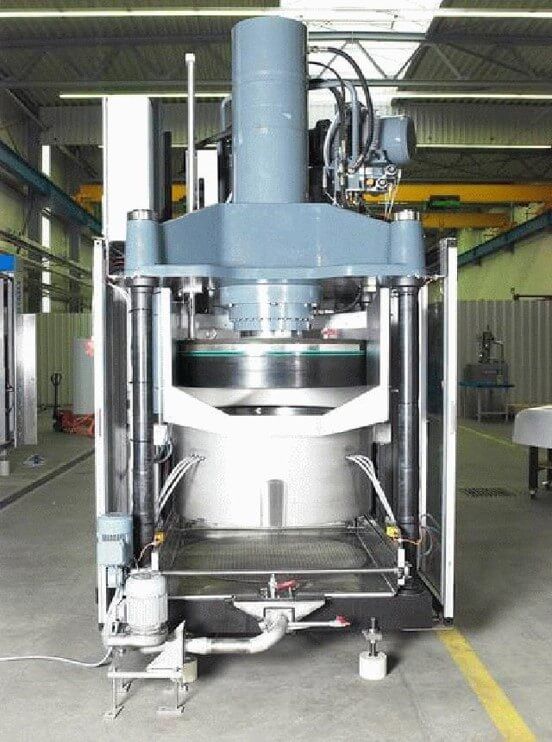
Holes can also form due to the pressing process in the laundry. This is where an immensely powerful press machine (see picture above) is used to squeeze the water out after washing. This forces air and water through the fabric with tremendous force. On finer, closely woven higher thread count fabric it’s difficult for the air and water to pass through. When this happens, it can burst the fabric and form a pattern of small holes where it’s been forced through (known as ‘pin holes’). This is known as hydro bursting.
To prevent holes and tears, bleach safely and only when necessary (follow the bleaching guidelines laid out earlier in this article). You should also regularly maintain laundry cages and machinery so there are no sharp edges. Both of these are good advice to use anywhere. Put simply, avoid putting your linen on or against rough surfaces where it can easily be snagged.
To prevent hydro bursting, a gentler series of short presses will gently expel a lot of the air and water before the fabric gets pressed with the full pressure.
How Bobbling & Pilling Can Occur On Bed Linen
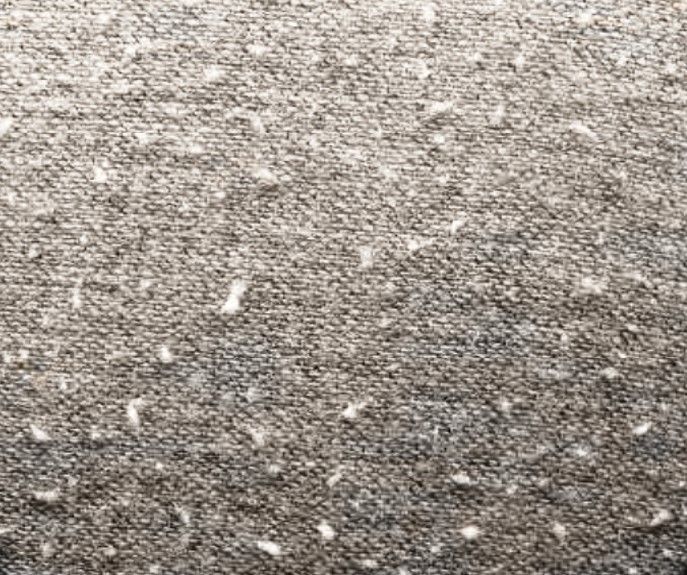
Over time, bed linen can begin to look bobbly on the surface. This can be due to a variety of reasons, ranging from how it’s manufactured to how it’s used.
From a manufacturing point of view, it could be that shorter fibres have been used to make the yarn. That yarn will be hairier because the shorter fibres will stick out and tangle to form the bobbles. If the manufacturer is using combed cotton to make the product (read our article for more information on carded and combed yarn), it’s less likely to bobble or pill as the short fibres have been removed.
It could also be that the fabric has not been singed properly. If the fabric hasn’t been singed, it can have a hairy surface where the fibres have not been burned away. Again, these will tangle and cause the fabric to pill.
The type of weave in the product also plays a part. For example, satin weaves will pill more easily as more of the yarn is exposed on the fabric surface to give that shiny appearance, rather than being intertwined with other yarns as they are in a plain weave.
From a laundry perspective, bleach or iron damage (see earlier) will weaken the fibres and allow them to break free from the fabric. This will cause them to bunch up on the fabric surface to form the bobbling. Also, if the filters on the laundry machinery are not cleaned regularly, lint can build up and attach to the fabric, which gives the appearance of pilling. This can also happen in a regular dryer at home.
Last but not least, pilling can and does occur as a result of misuse. For this example, we’re going to look at hotels.
It’s been known for housekeepers in hotels to use duvet covers as laundry bags to collect the used linen. These are then dragged across the floor while the housekeeper is doing their rounds. We know this because carpet fibres have been found embedded in the bobbles when investigating a pilling complaint.
So, pilling or bobbling can be because of any of these factors and could even be a combination of them. A little care and attention go a long way when it comes to your linen, so ensure you always follow washing instructions and the advice contained in this article and on our blog.
If you’d like to know more about preventing bobbling and pilling, we have an article on the topic that you can read here.
How Do Towels Become Bald And How Can I Prevent It?
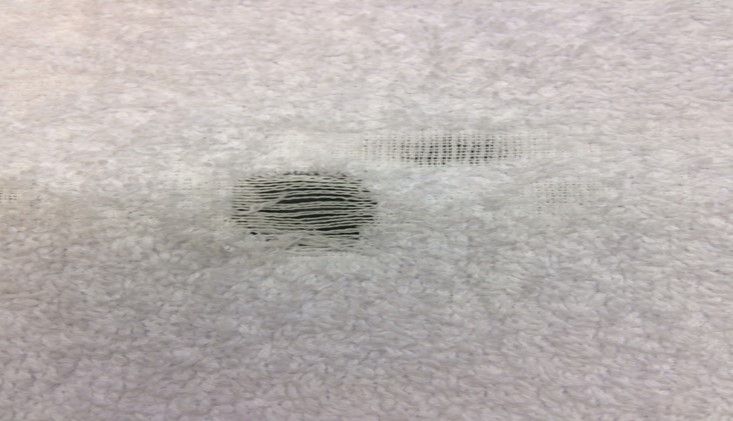
A bald towel is due to missing pile (the surface of loops or strands of yarn), leaving only the ground weave visible. The most common cause of this by far is where towels have been used as wiping cloths when cleaning areas such as bathrooms, especially by housekeepers in hotels.
Cleaning chemicals are quite corrosive, and they sit in the towel pile and eat away at the fibres whilst the towels are waiting to be laundered. You won’t actually notice any damage at this stage, that comes later.
During laundering, the mechanical action and the detergent removes the weak and damaged fibres. This leaves thin or bald patches where the cleaning chemicals were in contact with the towel. As you can imagine, this can result in a disagreement with a laundry contracted to clean the towels as, as far as the hotel is concerned, the towels were fine when sent to the laundry.
A simple way for a hotel to solve this is to properly train staff to not use the towels for cleaning purposes. This also applies to towels you have at home. Purchase cloths that are specifically for cleaning purposes rather than using an expensive towel to mop up.
Why Do My Towels Have A Harsh Feel And How Can I Prevent This?
You’ve just jumped out of the shower and wrapped yourself in a towel, but it doesn’t feel anywhere near as soft as it did the first time you used it. Or you own a hotel and guests have begun complaining that the towels you have supplied don’t feel nice to use. What gives?
Whether it’s a towel for personal use or a bulk lot of towels that hundreds of guests will end up using, you don’t want to feel like you’ve wasted your money, and nobody likes a harsh towel against their skin.
A towel that feels harsh can often be the result of the laundry process. If the towels are dried whilst the pile is still squashed down, as it will be if it’s been through the press, then it will feel very rough and look quite flat. Over drying the towels so they are bone dry will mean the fibres will be brittle, giving a harsh feel.
To prevent harsh towels, the towels should be tumbled for a few minutes at low temperature to allow them to break apart and the pile to open out. After this, turn the temperature up to fully dry them. Do it this way and you should end up with soft, fluffy towels.
If hard water is used during the laundry process, the pile loops can act as filters. These loops hold on to the fine mineral particles in hard water and make the pile feel quite rough. To avoid this, laundry water should be regularly tested for hardness and, if necessary, treated to soften the water.
For more tips on towel care, read our guide on 'how to keep towels soft and fluffy' and our guide on washing towels.
How To Prevent Pulled Threads On Towels
Pulled threads can be a common problem with towels. This is due to the pile on a towel, which is actually formed by a series of loops, easily getting caught. Yet, the pile loops on the towel shouldn’t be that easy to pull if the towel has been correctly looked after.
If towels that are new are easily pulled, then a likely reason is that they have not been given a good enough first wash. On a newly made towel, the ground weave is still relatively loose, and the yarns will still have some left over oils and lubricants on them from manufacture. This makes the yarns quite slippery, making pile loops more prone to pulling.
If the towels are just rinsed and not given a proper first wash before use, then the pile will pull out more easily during use and prematurely damage the towels.
To prevent this, the towels need a really good first wash in plenty of detergent (around three times as much as usual). This shrinks in and tightens up the ground weave, so it holds on to the pile and removes the lubricants. The result is the pile is much more difficult to pull.
Why Does My Linen Have A Washed Out Look And How Do I Prevent This?
Coloured linens such as tablecloths or towels can seem to lose colour and look washed out over time. This could be due the dyes used not being sufficiently colour fast. But more often than not it is due to the build-up of OBA on the surface of the fabric.
OBA stands for optical brightening agents and they’re designed to make whites look whiter. But if you’re washing coloured textiles in a detergent that contains OBA’s, these brighteners build-up on the fabric with every wash. When this happens the OBA actually masks the true colour of the linen, so the colour change is not colour loss, it’s actually OBA gain.
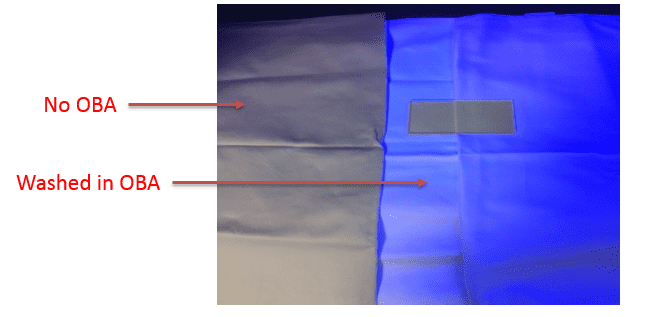
The photo above is taken under a UV light. It shows two table linen samples, where the first one is unwashed and the second one has been washed in OBA detergent. This fluoresces under UV light and you can see that is seems to have lost its colour. But if you look at the washed sample under a fluorescence suppressor glass you can see the true shade. The suppressor glass takes away the visual effects of the OBA to reveal the shade underneath.
The second photo is a towel that’s been washed in OBA detergent. You can also see the true shade under the glass.
OBA’s can have a major effect on the colour, particularly on light shades such as cream, beige and grey. To prevent this, coloured linens should ideally be washed in detergents that do not contain any OBA’s. That may be easier said than done if you are having your linen washed elsewhere, as the laundry may prefer to use the same detergent for everything if they launder both white and coloured items. But if you’re personally washing your linen, then check the bottle of the detergent your using to see if it contains any OBA’s and go and purchase one that doesn’t if the current bottle confirms it does.
Why Do My Towels Still Smell After They’ve Been To The Laundry?
We’ve been told that towels can sometimes give off a stale, not quite clean smell. This is because the towels have not been washed well enough to remove dead skin cells, faecal residue and general soil. These residues will encourage the growth of bacteria, which is what gives off the smell.
If your linen is being washed at a laundry and you suspect this is the case, then send them back to the laundry for a proper wash. If you’re washing them yourself, make sure you follow all washing instructions and take a look at our laundry advice guide.
If your linen smells a bit like vinegar, this is because the laundry will be using something called a sour. A sour is a weak acid that’s used to neutralise the bleach. If you can still smell this then it’s because the sour has not been fully rinsed out.


